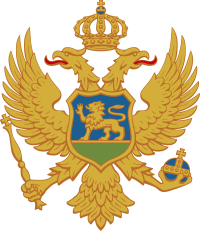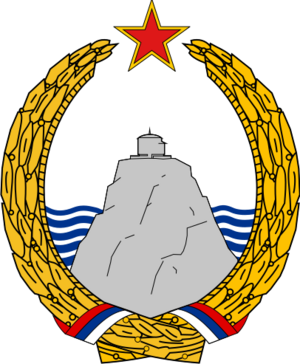Coat of arms of Montenegro facts for kids
Quick facts for kids Coat of arms of Montenegro |
|
|---|---|
 |
|
| Armiger | Montenegro |
| Adopted | 12 July 2004 |
The coat of arms of Montenegro is a special symbol for the country. It was officially chosen by the Parliament on 12 July 2004. You can see it on the flag of Montenegro and it's also used by the Armed Forces of Montenegro.
This important symbol was made part of the country's main rules, called the Constitution, on 2 October 2007.
Contents
What Does the Montenegrin Coat of Arms Look Like?
The official rules for Montenegro's national symbols describe the coat of arms clearly.
It shows a golden, two-headed eagle wearing a crown. The eagle has its wings spread, ready to fly. In its right claw, it holds a scepter (a fancy staff), and in its left claw, it holds a globus cruciger (a ball with a cross on top). The eagle itself is on a red background.
On the eagle's chest, there's a shield. This shield has a golden lion walking across it. The lion is on a green field with a blue sky behind it. The crown above the eagle's heads, and the scepter, are golden with a cross. The globus cruciger is blue with golden parts.
The Two-Headed Eagle Symbol
The main part of the coat of arms is the two-headed eagle. This symbol comes from old empires like the Byzantine Empire and even Ancient Rome. It usually means that the church and the government are either united or work very closely together.
Many old rulers in the area, like the House of Crnojević from a medieval state called Zeta, used this symbol. Other royal families across Europe also used it.
The design of Montenegro's coat of arms was inspired by the Russian Empire. This is because the ruling family of Montenegro, the House of Petrović-Njegoš, had strong family and political ties with Russia in the 1800s. That's when the coat of arms first looked like it does today.
The Lion on the Shield
The golden lion walking on the small shield is a sign of church authority. It might also represent the Lion of Judah, a powerful symbol. It also looks a bit like the lion used in the symbols of Venice, which had a big influence on Montenegro's history.
After Montenegro became independent from the Ottoman Empire, it became a country led by church leaders for a while. This was to help them stay strong against many attacks from the Turks. Because of this, the church's power was shown in many symbols of that time.
Later, around 1851, when the country started having kings instead of prince-bishops, the lion was moved below the eagle. The initials of the ruler, like Danilo I, Prince of Montenegro or King Nicholas I of Montenegro, were put on the shield instead.
Today's coat of arms puts the golden lion back on the shield. This removed the old monarch's initials. Montenegro is now a country where people vote for their leaders, and the church and state are separate. Even though the crown of the old Petrović-Njegoš family is still on the coat of arms, it's very popular. You can see it in schools, government buildings, and even in many homes and businesses. It's a common way for people to show their national pride.
Even though the description mentions a red background, the eagle is often shown without it. The red background is mainly used for the national seal and the national flag.
How National Symbols Are Used in Montenegro
The coat of arms and the flag must be used exactly as the law says. People can use them freely in art and for school projects, as long as it doesn't harm Montenegro's reputation or dignity.
It's not allowed to change, add to, or remove anything from the coat of arms or the flag. Sometimes, special rules might allow them to be part of other official symbols for government groups or institutions. But they can never be used for selling products or services.
The coat of arms and flag should not be used if they are damaged or look bad. Any damaged or unsuitable symbols must be taken out of use.
When Montenegro's coat of arms is shown with symbols from other countries or international groups, it always gets the most important spot. This "place of honor" means it's in the center of a circle, at the top of a half-circle, first in a row, or on the right side when looking at it. On official papers, it's usually at the top center or top left.
Where the Coat of Arms Must Be Used
- On the country's official seal.
- On seals of government offices and local councils.
- In official rooms of government buildings and on signs outside these buildings.
- In classrooms of schools and on signs outside school buildings.
- On buildings where Montenegro has representatives in other countries.
- On official documents used by government officials.
- On awards, diplomas, and honors given by Montenegro.
- On diplomas and certificates for finishing school.
- On identity cards for members of parliament, government officials, judges, and other public workers.
Where the Coat of Arms May Be Used
- During events like political meetings, science conferences, cultural festivals, art shows, or sports events where Montenegro is represented.
- On official thank-you notes, greeting cards, invitations, and other documents from the President, Parliament Chairman, Prime Minister, and other high-ranking officials.
- On official uniforms.
- In artistic creations and for educational purposes.
- In other situations allowed by law.
History of Montenegro's Coats of Arms
The story of Montenegro's state coat of arms began with the Crnojević noble family in the 1400s. Their family symbol, a golden crowned two-headed eagle on a red background, became the basis for Montenegro's state symbols. The two-headed eagle became the standard symbol for the country.
When the Petrović-Njegoš dynasty took power, they also used the golden two-headed eagle as the state symbol. Vladika Danilo added the Petrović-Njegoš family's larger coat of arms (a shield, crown, and fancy cloth) onto the eagle's chest. His successor, Vladika Sava, made big changes: he removed the family arms from the eagle's chest and added a sceptre and a globus cruciger (an imperial orb) in its claws. He also added another symbol that is still used today: a golden lion walking below the golden eagle. With Petar I, the coat of arms changed again: he removed the royal symbols from the eagle and put the Petrović-Njegoš family's middle arms on the eagle's chest, keeping the walking lion.
Prince Danilo also reorganized the coat of arms. He put a shield with a blue background and a golden lion walking on green ground onto the golden eagle's chest. In one claw, the eagle held the orb, and in the other, a sword and a scepter. During the time of King Nicholas I, the sword was removed. Later, in 1905, the eagle's color was changed from golden to silver, and the small shield's color changed from blue to red.
After World War II, Montenegro became a part of Second Yugoslavia. A new national emblem was adopted in 1945. It had a socialist design, with a Laurel wreath and a Red Star. The main picture was the Chapel of Lovćen mountain with sea waves behind it, showing Montenegro's access to the sea. This emblem was designed in 1944 by Milan Božović, styled in 1946 by Milo Milunović, and slightly changed in 1963 and 1974.
In 1993, the Montenegrin parliament brought back a proper coat of arms, returning to its historical roots. The old Montenegrin state's coat of arms was restored, but it was redesigned to look similar to the federal coat of arms. This new design was officially adopted on 6 January 1994.
See also
 In Spanish: Escudo de Montenegro para niños
In Spanish: Escudo de Montenegro para niños
- Lion passant
- Double-headed eagle
- Armorial of sovereign states


